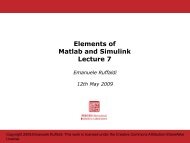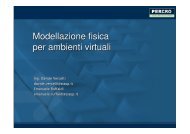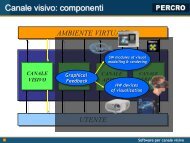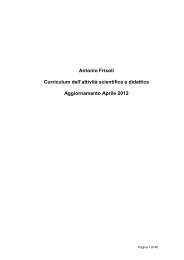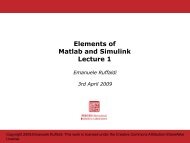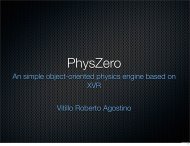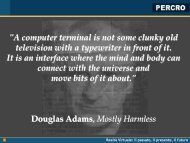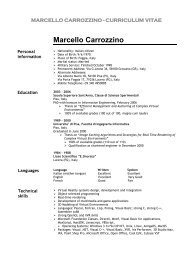English - Percro - Scuola Superiore Sant'Anna
English - Percro - Scuola Superiore Sant'Anna
English - Percro - Scuola Superiore Sant'Anna
Create successful ePaper yourself
Turn your PDF publications into a flip-book with our unique Google optimized e-Paper software.
Antonio Frisoli<br />
Curriculum vitae<br />
These activities has led in 2000 to the publication of one of the first studies on this topic<br />
[L16], where it was introduced a general methodology for the type synthesis of<br />
translational parallel mechanisms with theory of screws. More in detail, Antonio Frisoli<br />
has investigated the synthesis of innovative parallel manipulators with reduced number of<br />
degrees of freedom. He was one of the first to propose the derivation with an analytical<br />
methodology of all admissible parallel kinematics that can lead to pure translation motion<br />
of the upper platform. In the following, he had further developed these concepts to design<br />
and implement innovative concepts of haptic interfaces, with high dynamic performance<br />
and high position accuracy, that can be used for bilateral remote teleoperation control<br />
architectures. The developed methods led to the ideation and construction of two haptic<br />
interfaces with parallel kinematics and pure translational motion, based on a new parallel<br />
kinematic architecture that was selected on the basis of its high performance in terms of<br />
stiffness and dynamic bandwidth. More recently an interface for fMRI studies has been<br />
designed and built based on a 3RUR kinematics.<br />
Antonio Frisoli has also been working on performance analysis of parallel mechanisms<br />
with purely translational motion, studying the conditions of isotropy and force<br />
transmission, and developing an innovative method for exact calculation of maximum<br />
accuracy under joint clearances in purely translational parallel manipulators.<br />
Antonio Frisoli has further investigated the performance analysis of parallel mechanism<br />
with purely rotational mechanisms, by studying the conditions for kinematic isotropy and<br />
force transmissions. These concepts have been then extended to the synthesis of parallel<br />
manipulators with spherical motion, leading to the introduction of a new kinematics that<br />
making use of crossed-linked parallelograms allowed to extend significantly the angular<br />
range of motion of the end effector, with a significant application in the synthesis of<br />
surgical tools for laparoscopic surgery [68].<br />
Robot kinematics by means of screws theory<br />
Theory of screws and analysis of kinematic law in the framework of differential geometry<br />
(Lie groups, Lie algebras) represent a powerful tool form the analytical and geometric<br />
point of view for the resolution of spatial kinematic problem, such as in the case of robot<br />
design. Antonio Frisoli has investigated and extended the tools of screws theory to study<br />
the acceleration properties of robots, deriving a new method for the analysis of parallel<br />
manipulators [L15].<br />
He has made use of the developed techniques for different kind of applications, such as<br />
type-synthesis of new kinematics, analysis of parallel manipulators and gravity<br />
compensation laws.<br />
Extension of screw theory methods to dynamic analysis of parallel manipulators<br />
The developed methods were further extended to the movement and dynamic analysis of<br />
parallel manipulators, such as Gough-Stewart platforms, used in inertial motion<br />
simulators, MORIS (motorbike simulator) and INDICA (forklift simulator), developed at<br />
PERCRO laboratory in the associated research projects [L11, 103, R25].<br />
The methodology of analysis based on screw theory was extended to the Hamiltonian<br />
formulation in the dynamics of robotic systems [L15], that can be directly used for the<br />
synthesis of control systems, exhibiting robustness to time delay in the signal<br />
transmission or computation eventually present in the system.<br />
In collaboration with Prof. Rico [R25], Antonio Frisoli has also developed a generalized<br />
method based on the extension of the theory of the screws to higher order motion<br />
analysis, with the introduction of accelerators for the dynamic analysis of parallel<br />
systems. Their fundamental work on the subject has shown the application of the<br />
methodology for modeling the dynamics of a Stewart platform and a parallel wrist with two<br />
degrees of freedom.<br />
Page 10 of 46



